Singapore Airlines: External Environment and Management Analysis
VerifiedAdded on 2020/05/16
|14
|3394
|94
Report
AI Summary
This report provides a comprehensive analysis of Singapore Airlines (SIA), examining its business efficiency and competitive environment. It begins with an introduction to SIA, including its history, subsidiaries, and market position, highlighting its ranking as the second-largest airline by market capitalization. The report then conducts a PESTEL analysis of the airline industry, assessing the impact of political, economic, social, technological, environmental, and legal factors on SIA's operations. Following this, Porter's Five Forces analysis is applied to evaluate the competitive landscape, including the threat of new entrants, industry rivalry, the threat of substitution, supplier power, and buyer power. The analysis reveals the external factors affecting SIA's operations and the competitive pressures it faces. The report concludes with management recommendations for SIA to maintain its premier status, such as introducing loyalty schemes and exploring opportunities in low-cost carrier markets. Overall, the report offers a detailed overview of SIA's current state and operating environment, drawing on PESTEL and Porter's analysis to inform its conclusions.
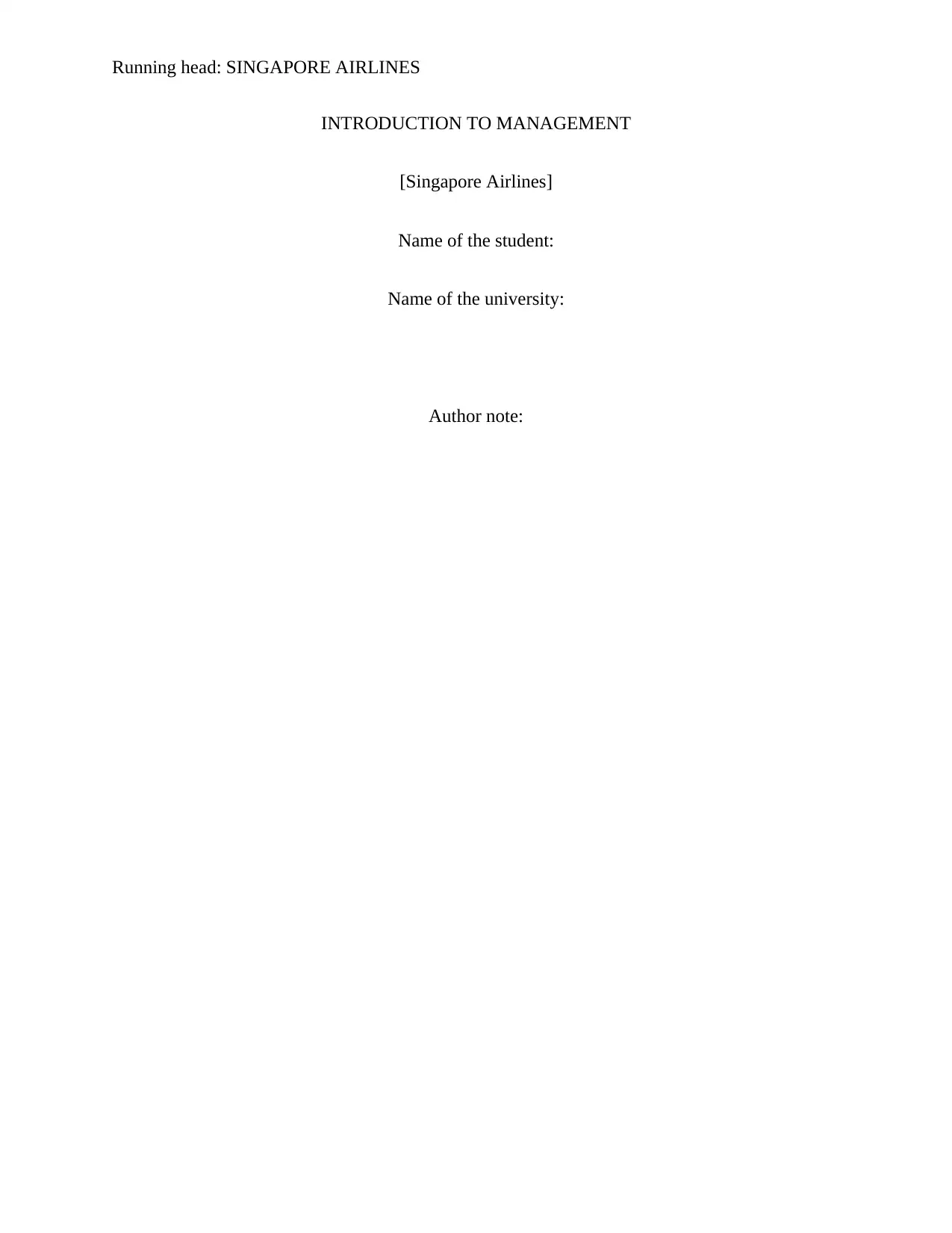
Running head: SINGAPORE AIRLINES
INTRODUCTION TO MANAGEMENT
[Singapore Airlines]
Name of the student:
Name of the university:
Author note:
INTRODUCTION TO MANAGEMENT
[Singapore Airlines]
Name of the student:
Name of the university:
Author note:
Paraphrase This Document
Need a fresh take? Get an instant paraphrase of this document with our AI Paraphraser
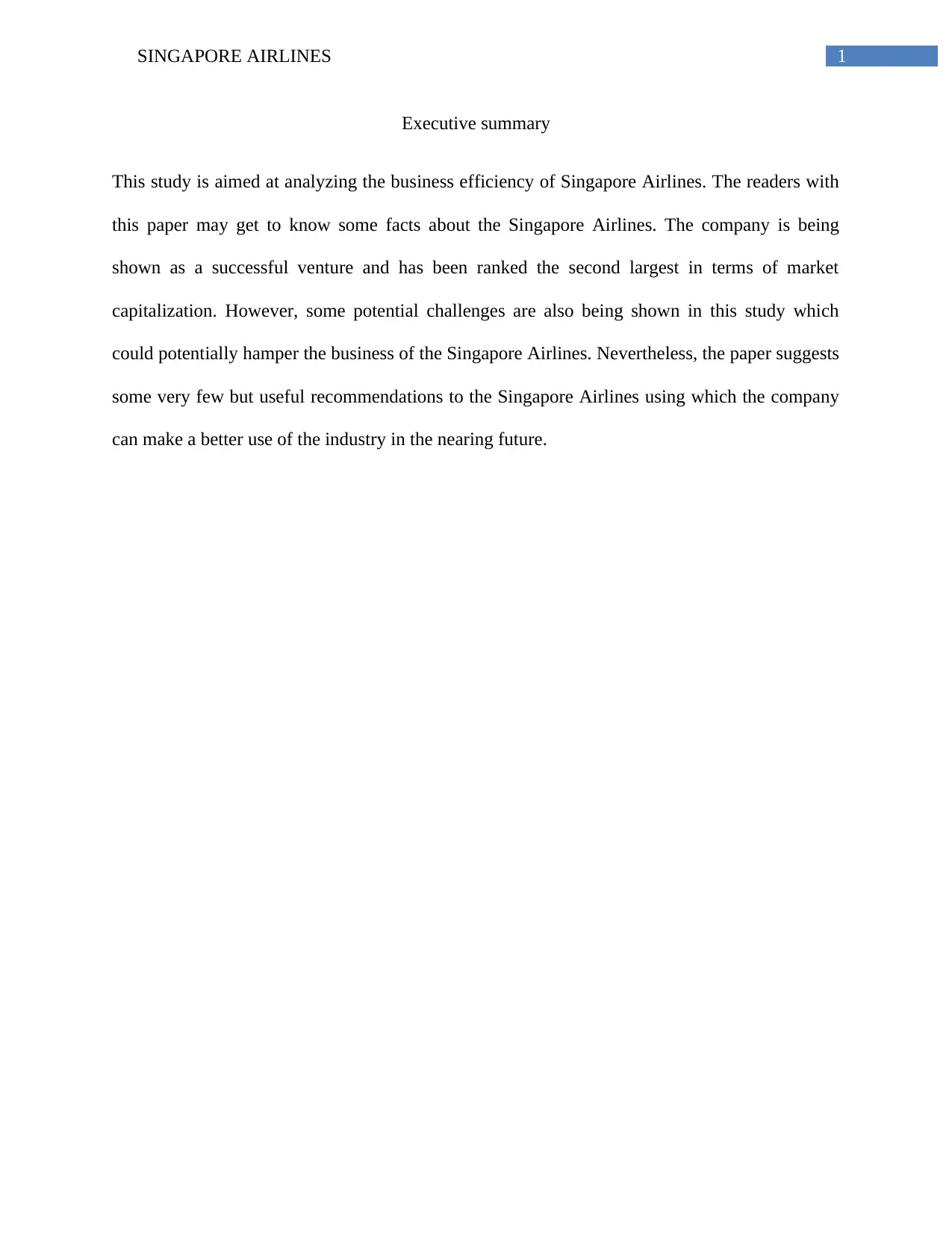
1SINGAPORE AIRLINES
Executive summary
This study is aimed at analyzing the business efficiency of Singapore Airlines. The readers with
this paper may get to know some facts about the Singapore Airlines. The company is being
shown as a successful venture and has been ranked the second largest in terms of market
capitalization. However, some potential challenges are also being shown in this study which
could potentially hamper the business of the Singapore Airlines. Nevertheless, the paper suggests
some very few but useful recommendations to the Singapore Airlines using which the company
can make a better use of the industry in the nearing future.
Executive summary
This study is aimed at analyzing the business efficiency of Singapore Airlines. The readers with
this paper may get to know some facts about the Singapore Airlines. The company is being
shown as a successful venture and has been ranked the second largest in terms of market
capitalization. However, some potential challenges are also being shown in this study which
could potentially hamper the business of the Singapore Airlines. Nevertheless, the paper suggests
some very few but useful recommendations to the Singapore Airlines using which the company
can make a better use of the industry in the nearing future.
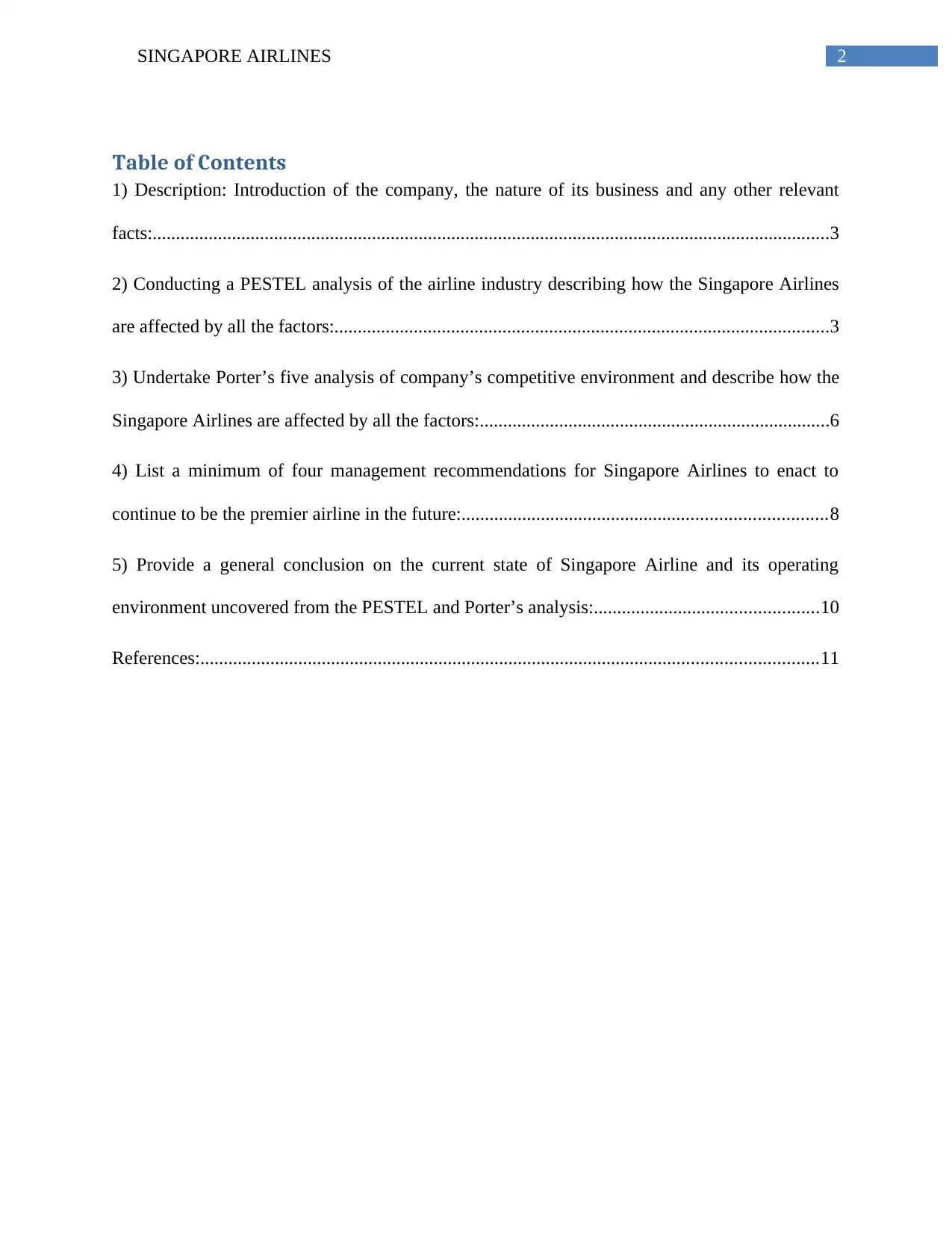
2SINGAPORE AIRLINES
Table of Contents
1) Description: Introduction of the company, the nature of its business and any other relevant
facts:.................................................................................................................................................3
2) Conducting a PESTEL analysis of the airline industry describing how the Singapore Airlines
are affected by all the factors:..........................................................................................................3
3) Undertake Porter’s five analysis of company’s competitive environment and describe how the
Singapore Airlines are affected by all the factors:...........................................................................6
4) List a minimum of four management recommendations for Singapore Airlines to enact to
continue to be the premier airline in the future:..............................................................................8
5) Provide a general conclusion on the current state of Singapore Airline and its operating
environment uncovered from the PESTEL and Porter’s analysis:................................................10
References:....................................................................................................................................11
Table of Contents
1) Description: Introduction of the company, the nature of its business and any other relevant
facts:.................................................................................................................................................3
2) Conducting a PESTEL analysis of the airline industry describing how the Singapore Airlines
are affected by all the factors:..........................................................................................................3
3) Undertake Porter’s five analysis of company’s competitive environment and describe how the
Singapore Airlines are affected by all the factors:...........................................................................6
4) List a minimum of four management recommendations for Singapore Airlines to enact to
continue to be the premier airline in the future:..............................................................................8
5) Provide a general conclusion on the current state of Singapore Airline and its operating
environment uncovered from the PESTEL and Porter’s analysis:................................................10
References:....................................................................................................................................11
⊘ This is a preview!⊘
Do you want full access?
Subscribe today to unlock all pages.

Trusted by 1+ million students worldwide
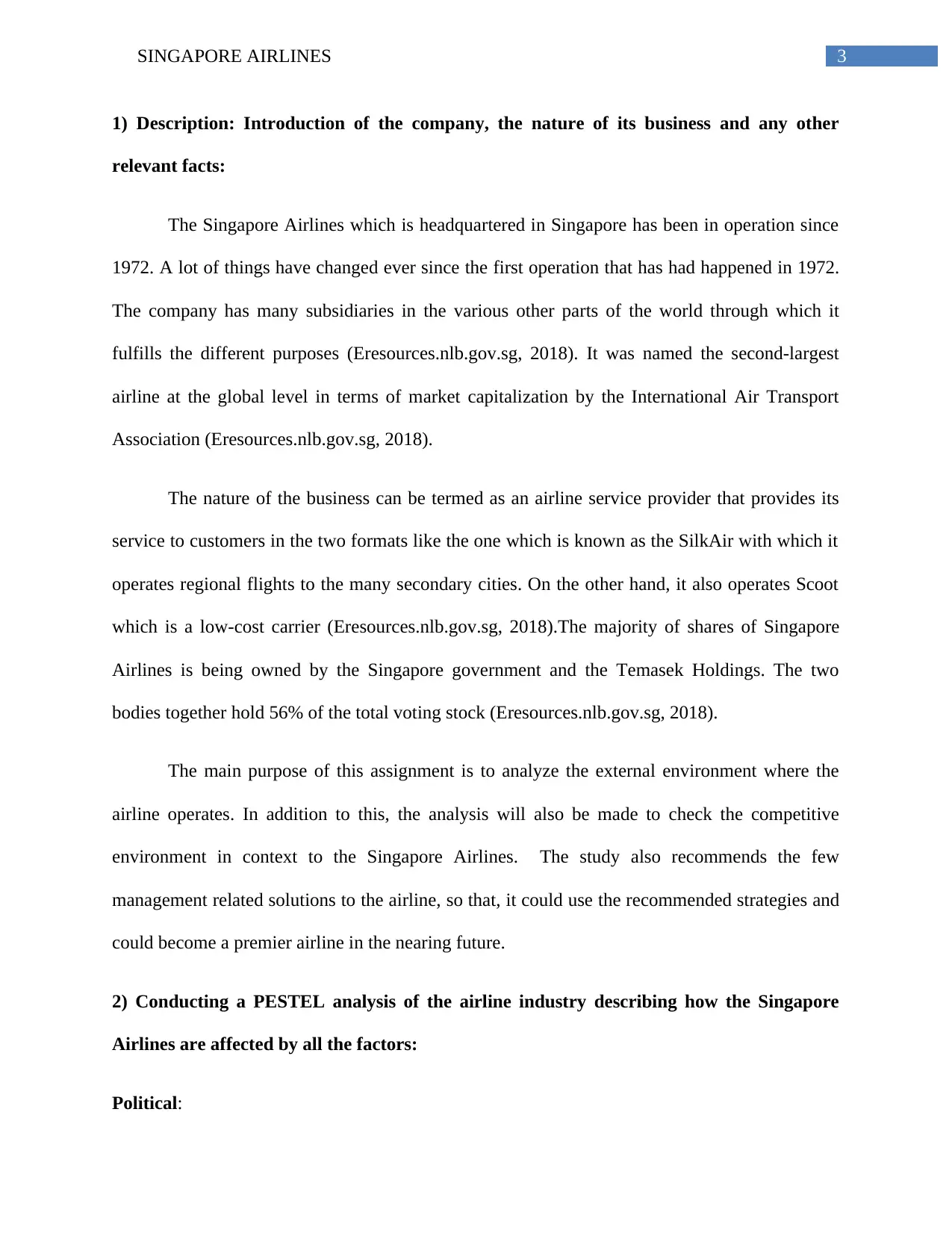
3SINGAPORE AIRLINES
1) Description: Introduction of the company, the nature of its business and any other
relevant facts:
The Singapore Airlines which is headquartered in Singapore has been in operation since
1972. A lot of things have changed ever since the first operation that has had happened in 1972.
The company has many subsidiaries in the various other parts of the world through which it
fulfills the different purposes (Eresources.nlb.gov.sg, 2018). It was named the second-largest
airline at the global level in terms of market capitalization by the International Air Transport
Association (Eresources.nlb.gov.sg, 2018).
The nature of the business can be termed as an airline service provider that provides its
service to customers in the two formats like the one which is known as the SilkAir with which it
operates regional flights to the many secondary cities. On the other hand, it also operates Scoot
which is a low-cost carrier (Eresources.nlb.gov.sg, 2018).The majority of shares of Singapore
Airlines is being owned by the Singapore government and the Temasek Holdings. The two
bodies together hold 56% of the total voting stock (Eresources.nlb.gov.sg, 2018).
The main purpose of this assignment is to analyze the external environment where the
airline operates. In addition to this, the analysis will also be made to check the competitive
environment in context to the Singapore Airlines. The study also recommends the few
management related solutions to the airline, so that, it could use the recommended strategies and
could become a premier airline in the nearing future.
2) Conducting a PESTEL analysis of the airline industry describing how the Singapore
Airlines are affected by all the factors:
Political:
1) Description: Introduction of the company, the nature of its business and any other
relevant facts:
The Singapore Airlines which is headquartered in Singapore has been in operation since
1972. A lot of things have changed ever since the first operation that has had happened in 1972.
The company has many subsidiaries in the various other parts of the world through which it
fulfills the different purposes (Eresources.nlb.gov.sg, 2018). It was named the second-largest
airline at the global level in terms of market capitalization by the International Air Transport
Association (Eresources.nlb.gov.sg, 2018).
The nature of the business can be termed as an airline service provider that provides its
service to customers in the two formats like the one which is known as the SilkAir with which it
operates regional flights to the many secondary cities. On the other hand, it also operates Scoot
which is a low-cost carrier (Eresources.nlb.gov.sg, 2018).The majority of shares of Singapore
Airlines is being owned by the Singapore government and the Temasek Holdings. The two
bodies together hold 56% of the total voting stock (Eresources.nlb.gov.sg, 2018).
The main purpose of this assignment is to analyze the external environment where the
airline operates. In addition to this, the analysis will also be made to check the competitive
environment in context to the Singapore Airlines. The study also recommends the few
management related solutions to the airline, so that, it could use the recommended strategies and
could become a premier airline in the nearing future.
2) Conducting a PESTEL analysis of the airline industry describing how the Singapore
Airlines are affected by all the factors:
Political:
Paraphrase This Document
Need a fresh take? Get an instant paraphrase of this document with our AI Paraphraser
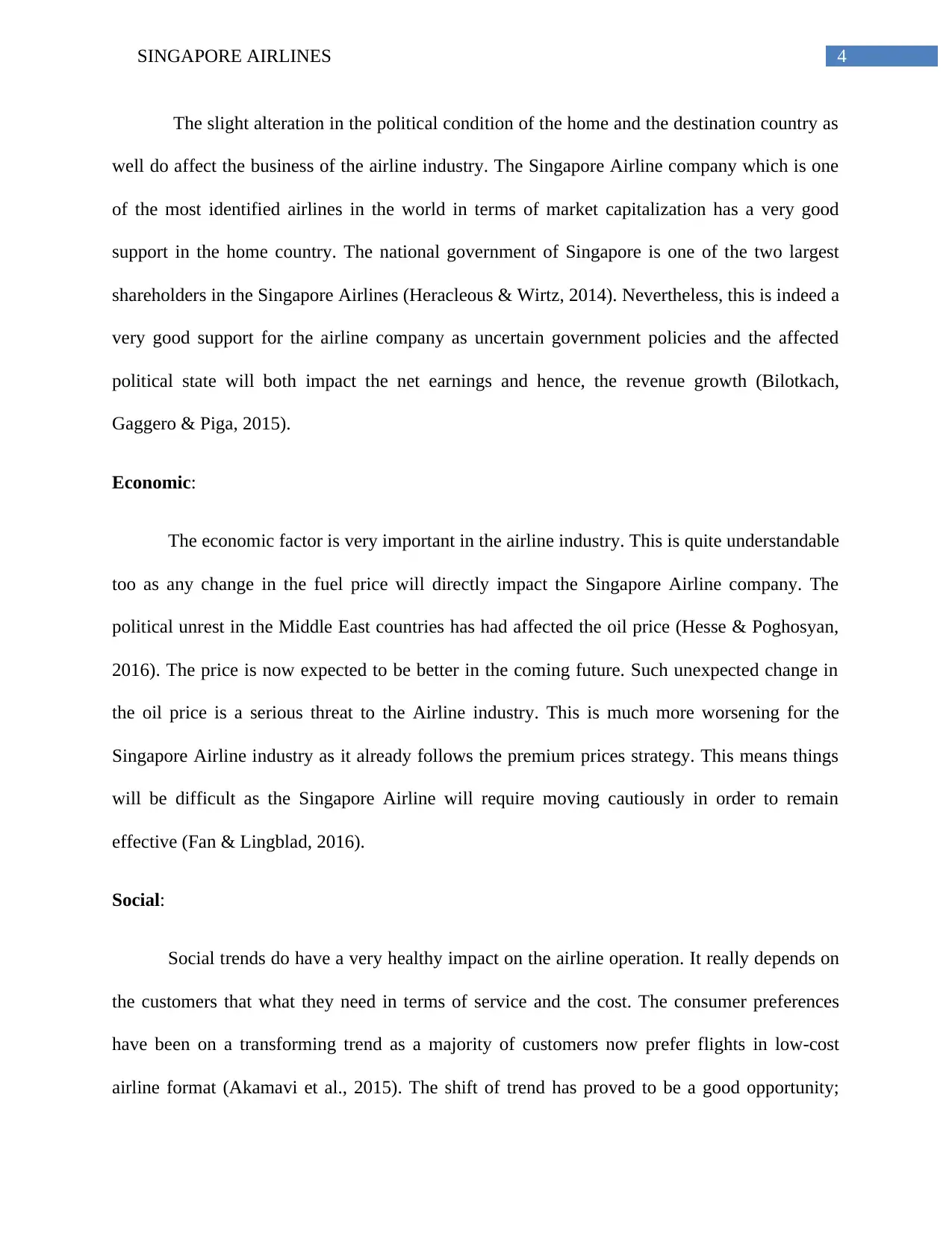
4SINGAPORE AIRLINES
The slight alteration in the political condition of the home and the destination country as
well do affect the business of the airline industry. The Singapore Airline company which is one
of the most identified airlines in the world in terms of market capitalization has a very good
support in the home country. The national government of Singapore is one of the two largest
shareholders in the Singapore Airlines (Heracleous & Wirtz, 2014). Nevertheless, this is indeed a
very good support for the airline company as uncertain government policies and the affected
political state will both impact the net earnings and hence, the revenue growth (Bilotkach,
Gaggero & Piga, 2015).
Economic:
The economic factor is very important in the airline industry. This is quite understandable
too as any change in the fuel price will directly impact the Singapore Airline company. The
political unrest in the Middle East countries has had affected the oil price (Hesse & Poghosyan,
2016). The price is now expected to be better in the coming future. Such unexpected change in
the oil price is a serious threat to the Airline industry. This is much more worsening for the
Singapore Airline industry as it already follows the premium prices strategy. This means things
will be difficult as the Singapore Airline will require moving cautiously in order to remain
effective (Fan & Lingblad, 2016).
Social:
Social trends do have a very healthy impact on the airline operation. It really depends on
the customers that what they need in terms of service and the cost. The consumer preferences
have been on a transforming trend as a majority of customers now prefer flights in low-cost
airline format (Akamavi et al., 2015). The shift of trend has proved to be a good opportunity;
The slight alteration in the political condition of the home and the destination country as
well do affect the business of the airline industry. The Singapore Airline company which is one
of the most identified airlines in the world in terms of market capitalization has a very good
support in the home country. The national government of Singapore is one of the two largest
shareholders in the Singapore Airlines (Heracleous & Wirtz, 2014). Nevertheless, this is indeed a
very good support for the airline company as uncertain government policies and the affected
political state will both impact the net earnings and hence, the revenue growth (Bilotkach,
Gaggero & Piga, 2015).
Economic:
The economic factor is very important in the airline industry. This is quite understandable
too as any change in the fuel price will directly impact the Singapore Airline company. The
political unrest in the Middle East countries has had affected the oil price (Hesse & Poghosyan,
2016). The price is now expected to be better in the coming future. Such unexpected change in
the oil price is a serious threat to the Airline industry. This is much more worsening for the
Singapore Airline industry as it already follows the premium prices strategy. This means things
will be difficult as the Singapore Airline will require moving cautiously in order to remain
effective (Fan & Lingblad, 2016).
Social:
Social trends do have a very healthy impact on the airline operation. It really depends on
the customers that what they need in terms of service and the cost. The consumer preferences
have been on a transforming trend as a majority of customers now prefer flights in low-cost
airline format (Akamavi et al., 2015). The shift of trend has proved to be a good opportunity;
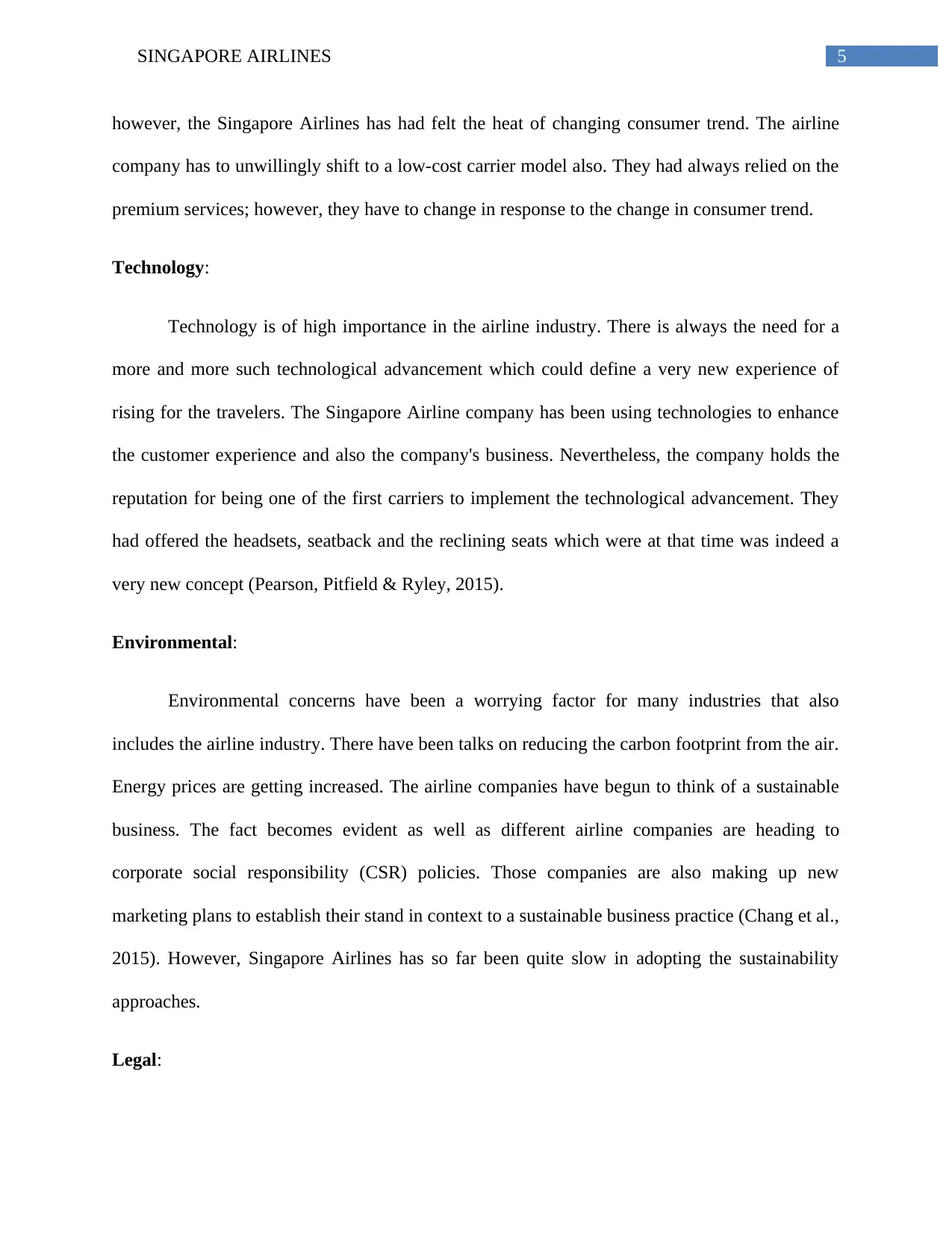
5SINGAPORE AIRLINES
however, the Singapore Airlines has had felt the heat of changing consumer trend. The airline
company has to unwillingly shift to a low-cost carrier model also. They had always relied on the
premium services; however, they have to change in response to the change in consumer trend.
Technology:
Technology is of high importance in the airline industry. There is always the need for a
more and more such technological advancement which could define a very new experience of
rising for the travelers. The Singapore Airline company has been using technologies to enhance
the customer experience and also the company's business. Nevertheless, the company holds the
reputation for being one of the first carriers to implement the technological advancement. They
had offered the headsets, seatback and the reclining seats which were at that time was indeed a
very new concept (Pearson, Pitfield & Ryley, 2015).
Environmental:
Environmental concerns have been a worrying factor for many industries that also
includes the airline industry. There have been talks on reducing the carbon footprint from the air.
Energy prices are getting increased. The airline companies have begun to think of a sustainable
business. The fact becomes evident as well as different airline companies are heading to
corporate social responsibility (CSR) policies. Those companies are also making up new
marketing plans to establish their stand in context to a sustainable business practice (Chang et al.,
2015). However, Singapore Airlines has so far been quite slow in adopting the sustainability
approaches.
Legal:
however, the Singapore Airlines has had felt the heat of changing consumer trend. The airline
company has to unwillingly shift to a low-cost carrier model also. They had always relied on the
premium services; however, they have to change in response to the change in consumer trend.
Technology:
Technology is of high importance in the airline industry. There is always the need for a
more and more such technological advancement which could define a very new experience of
rising for the travelers. The Singapore Airline company has been using technologies to enhance
the customer experience and also the company's business. Nevertheless, the company holds the
reputation for being one of the first carriers to implement the technological advancement. They
had offered the headsets, seatback and the reclining seats which were at that time was indeed a
very new concept (Pearson, Pitfield & Ryley, 2015).
Environmental:
Environmental concerns have been a worrying factor for many industries that also
includes the airline industry. There have been talks on reducing the carbon footprint from the air.
Energy prices are getting increased. The airline companies have begun to think of a sustainable
business. The fact becomes evident as well as different airline companies are heading to
corporate social responsibility (CSR) policies. Those companies are also making up new
marketing plans to establish their stand in context to a sustainable business practice (Chang et al.,
2015). However, Singapore Airlines has so far been quite slow in adopting the sustainability
approaches.
Legal:
⊘ This is a preview!⊘
Do you want full access?
Subscribe today to unlock all pages.

Trusted by 1+ million students worldwide
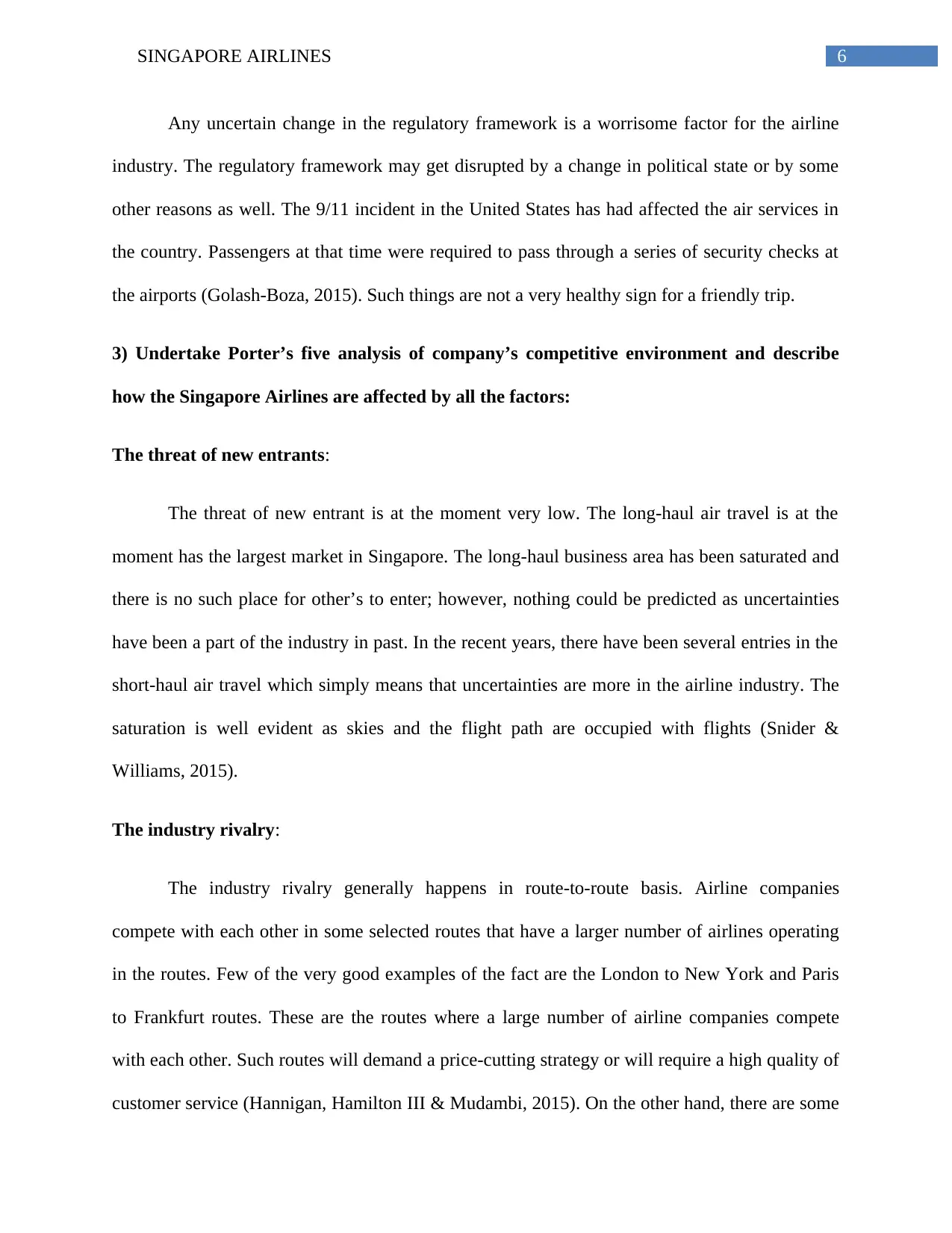
6SINGAPORE AIRLINES
Any uncertain change in the regulatory framework is a worrisome factor for the airline
industry. The regulatory framework may get disrupted by a change in political state or by some
other reasons as well. The 9/11 incident in the United States has had affected the air services in
the country. Passengers at that time were required to pass through a series of security checks at
the airports (Golash-Boza, 2015). Such things are not a very healthy sign for a friendly trip.
3) Undertake Porter’s five analysis of company’s competitive environment and describe
how the Singapore Airlines are affected by all the factors:
The threat of new entrants:
The threat of new entrant is at the moment very low. The long-haul air travel is at the
moment has the largest market in Singapore. The long-haul business area has been saturated and
there is no such place for other’s to enter; however, nothing could be predicted as uncertainties
have been a part of the industry in past. In the recent years, there have been several entries in the
short-haul air travel which simply means that uncertainties are more in the airline industry. The
saturation is well evident as skies and the flight path are occupied with flights (Snider &
Williams, 2015).
The industry rivalry:
The industry rivalry generally happens in route-to-route basis. Airline companies
compete with each other in some selected routes that have a larger number of airlines operating
in the routes. Few of the very good examples of the fact are the London to New York and Paris
to Frankfurt routes. These are the routes where a large number of airline companies compete
with each other. Such routes will demand a price-cutting strategy or will require a high quality of
customer service (Hannigan, Hamilton III & Mudambi, 2015). On the other hand, there are some
Any uncertain change in the regulatory framework is a worrisome factor for the airline
industry. The regulatory framework may get disrupted by a change in political state or by some
other reasons as well. The 9/11 incident in the United States has had affected the air services in
the country. Passengers at that time were required to pass through a series of security checks at
the airports (Golash-Boza, 2015). Such things are not a very healthy sign for a friendly trip.
3) Undertake Porter’s five analysis of company’s competitive environment and describe
how the Singapore Airlines are affected by all the factors:
The threat of new entrants:
The threat of new entrant is at the moment very low. The long-haul air travel is at the
moment has the largest market in Singapore. The long-haul business area has been saturated and
there is no such place for other’s to enter; however, nothing could be predicted as uncertainties
have been a part of the industry in past. In the recent years, there have been several entries in the
short-haul air travel which simply means that uncertainties are more in the airline industry. The
saturation is well evident as skies and the flight path are occupied with flights (Snider &
Williams, 2015).
The industry rivalry:
The industry rivalry generally happens in route-to-route basis. Airline companies
compete with each other in some selected routes that have a larger number of airlines operating
in the routes. Few of the very good examples of the fact are the London to New York and Paris
to Frankfurt routes. These are the routes where a large number of airline companies compete
with each other. Such routes will demand a price-cutting strategy or will require a high quality of
customer service (Hannigan, Hamilton III & Mudambi, 2015). On the other hand, there are some
Paraphrase This Document
Need a fresh take? Get an instant paraphrase of this document with our AI Paraphraser
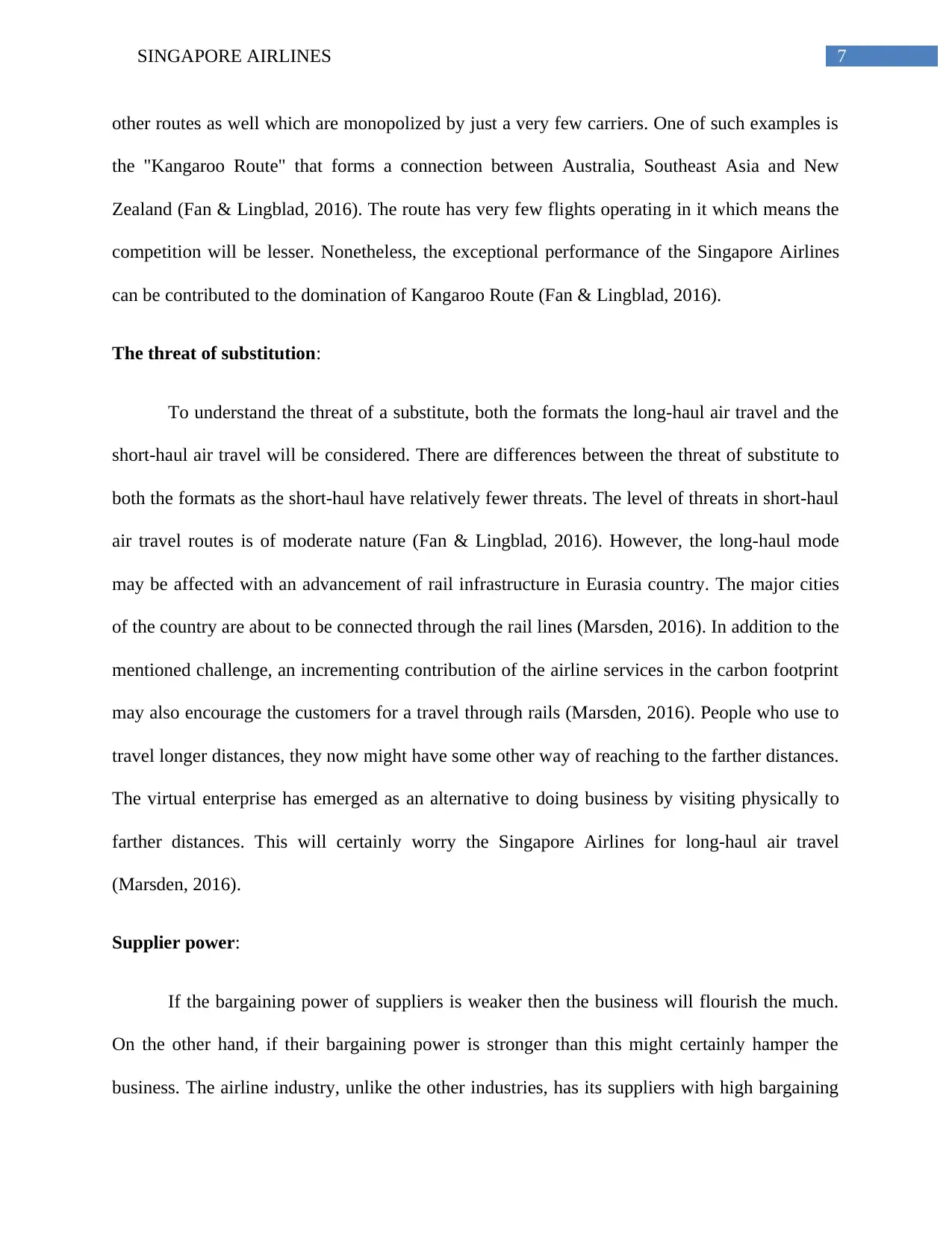
7SINGAPORE AIRLINES
other routes as well which are monopolized by just a very few carriers. One of such examples is
the "Kangaroo Route" that forms a connection between Australia, Southeast Asia and New
Zealand (Fan & Lingblad, 2016). The route has very few flights operating in it which means the
competition will be lesser. Nonetheless, the exceptional performance of the Singapore Airlines
can be contributed to the domination of Kangaroo Route (Fan & Lingblad, 2016).
The threat of substitution:
To understand the threat of a substitute, both the formats the long-haul air travel and the
short-haul air travel will be considered. There are differences between the threat of substitute to
both the formats as the short-haul have relatively fewer threats. The level of threats in short-haul
air travel routes is of moderate nature (Fan & Lingblad, 2016). However, the long-haul mode
may be affected with an advancement of rail infrastructure in Eurasia country. The major cities
of the country are about to be connected through the rail lines (Marsden, 2016). In addition to the
mentioned challenge, an incrementing contribution of the airline services in the carbon footprint
may also encourage the customers for a travel through rails (Marsden, 2016). People who use to
travel longer distances, they now might have some other way of reaching to the farther distances.
The virtual enterprise has emerged as an alternative to doing business by visiting physically to
farther distances. This will certainly worry the Singapore Airlines for long-haul air travel
(Marsden, 2016).
Supplier power:
If the bargaining power of suppliers is weaker then the business will flourish the much.
On the other hand, if their bargaining power is stronger than this might certainly hamper the
business. The airline industry, unlike the other industries, has its suppliers with high bargaining
other routes as well which are monopolized by just a very few carriers. One of such examples is
the "Kangaroo Route" that forms a connection between Australia, Southeast Asia and New
Zealand (Fan & Lingblad, 2016). The route has very few flights operating in it which means the
competition will be lesser. Nonetheless, the exceptional performance of the Singapore Airlines
can be contributed to the domination of Kangaroo Route (Fan & Lingblad, 2016).
The threat of substitution:
To understand the threat of a substitute, both the formats the long-haul air travel and the
short-haul air travel will be considered. There are differences between the threat of substitute to
both the formats as the short-haul have relatively fewer threats. The level of threats in short-haul
air travel routes is of moderate nature (Fan & Lingblad, 2016). However, the long-haul mode
may be affected with an advancement of rail infrastructure in Eurasia country. The major cities
of the country are about to be connected through the rail lines (Marsden, 2016). In addition to the
mentioned challenge, an incrementing contribution of the airline services in the carbon footprint
may also encourage the customers for a travel through rails (Marsden, 2016). People who use to
travel longer distances, they now might have some other way of reaching to the farther distances.
The virtual enterprise has emerged as an alternative to doing business by visiting physically to
farther distances. This will certainly worry the Singapore Airlines for long-haul air travel
(Marsden, 2016).
Supplier power:
If the bargaining power of suppliers is weaker then the business will flourish the much.
On the other hand, if their bargaining power is stronger than this might certainly hamper the
business. The airline industry, unlike the other industries, has its suppliers with high bargaining
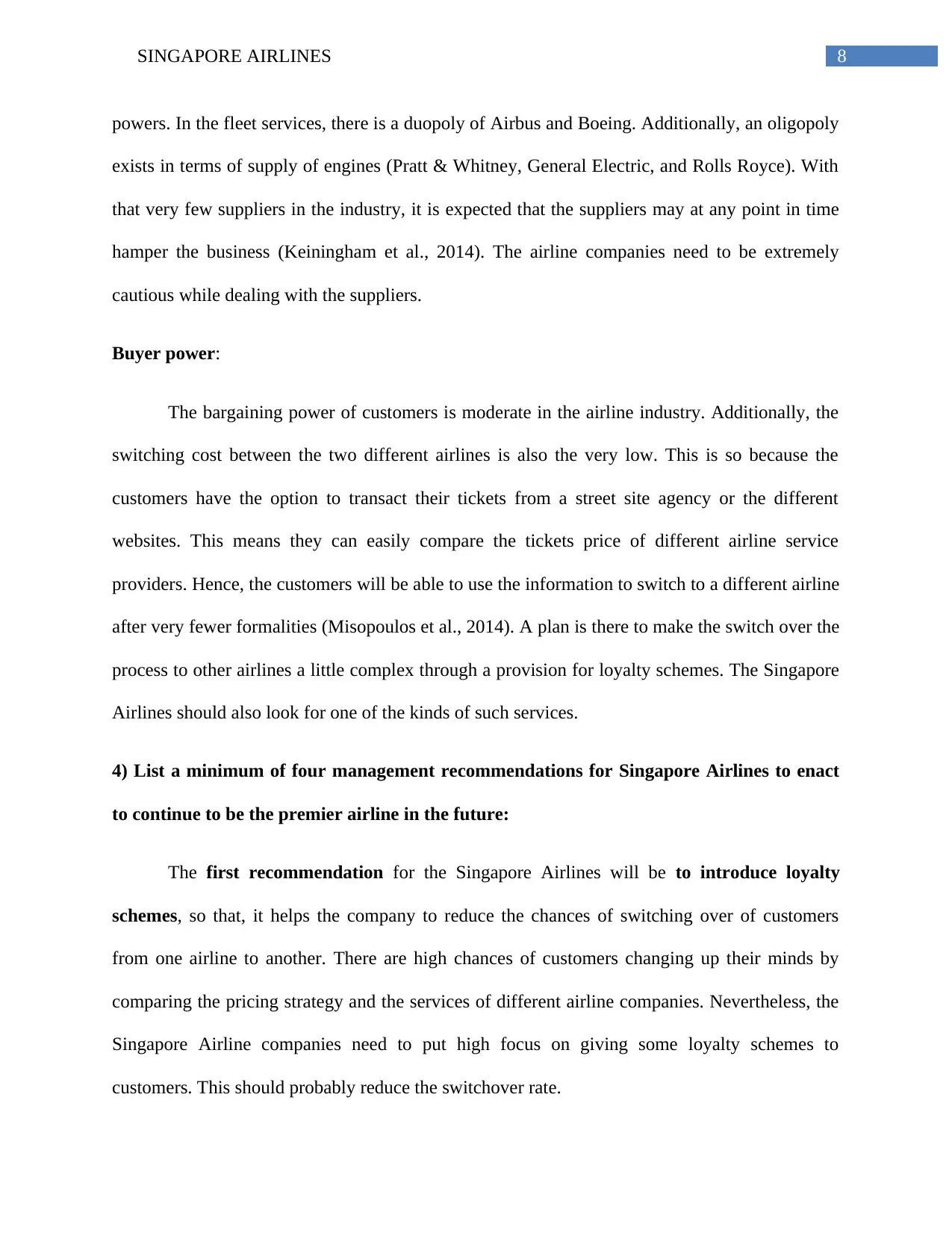
8SINGAPORE AIRLINES
powers. In the fleet services, there is a duopoly of Airbus and Boeing. Additionally, an oligopoly
exists in terms of supply of engines (Pratt & Whitney, General Electric, and Rolls Royce). With
that very few suppliers in the industry, it is expected that the suppliers may at any point in time
hamper the business (Keiningham et al., 2014). The airline companies need to be extremely
cautious while dealing with the suppliers.
Buyer power:
The bargaining power of customers is moderate in the airline industry. Additionally, the
switching cost between the two different airlines is also the very low. This is so because the
customers have the option to transact their tickets from a street site agency or the different
websites. This means they can easily compare the tickets price of different airline service
providers. Hence, the customers will be able to use the information to switch to a different airline
after very fewer formalities (Misopoulos et al., 2014). A plan is there to make the switch over the
process to other airlines a little complex through a provision for loyalty schemes. The Singapore
Airlines should also look for one of the kinds of such services.
4) List a minimum of four management recommendations for Singapore Airlines to enact
to continue to be the premier airline in the future:
The first recommendation for the Singapore Airlines will be to introduce loyalty
schemes, so that, it helps the company to reduce the chances of switching over of customers
from one airline to another. There are high chances of customers changing up their minds by
comparing the pricing strategy and the services of different airline companies. Nevertheless, the
Singapore Airline companies need to put high focus on giving some loyalty schemes to
customers. This should probably reduce the switchover rate.
powers. In the fleet services, there is a duopoly of Airbus and Boeing. Additionally, an oligopoly
exists in terms of supply of engines (Pratt & Whitney, General Electric, and Rolls Royce). With
that very few suppliers in the industry, it is expected that the suppliers may at any point in time
hamper the business (Keiningham et al., 2014). The airline companies need to be extremely
cautious while dealing with the suppliers.
Buyer power:
The bargaining power of customers is moderate in the airline industry. Additionally, the
switching cost between the two different airlines is also the very low. This is so because the
customers have the option to transact their tickets from a street site agency or the different
websites. This means they can easily compare the tickets price of different airline service
providers. Hence, the customers will be able to use the information to switch to a different airline
after very fewer formalities (Misopoulos et al., 2014). A plan is there to make the switch over the
process to other airlines a little complex through a provision for loyalty schemes. The Singapore
Airlines should also look for one of the kinds of such services.
4) List a minimum of four management recommendations for Singapore Airlines to enact
to continue to be the premier airline in the future:
The first recommendation for the Singapore Airlines will be to introduce loyalty
schemes, so that, it helps the company to reduce the chances of switching over of customers
from one airline to another. There are high chances of customers changing up their minds by
comparing the pricing strategy and the services of different airline companies. Nevertheless, the
Singapore Airline companies need to put high focus on giving some loyalty schemes to
customers. This should probably reduce the switchover rate.
⊘ This is a preview!⊘
Do you want full access?
Subscribe today to unlock all pages.

Trusted by 1+ million students worldwide
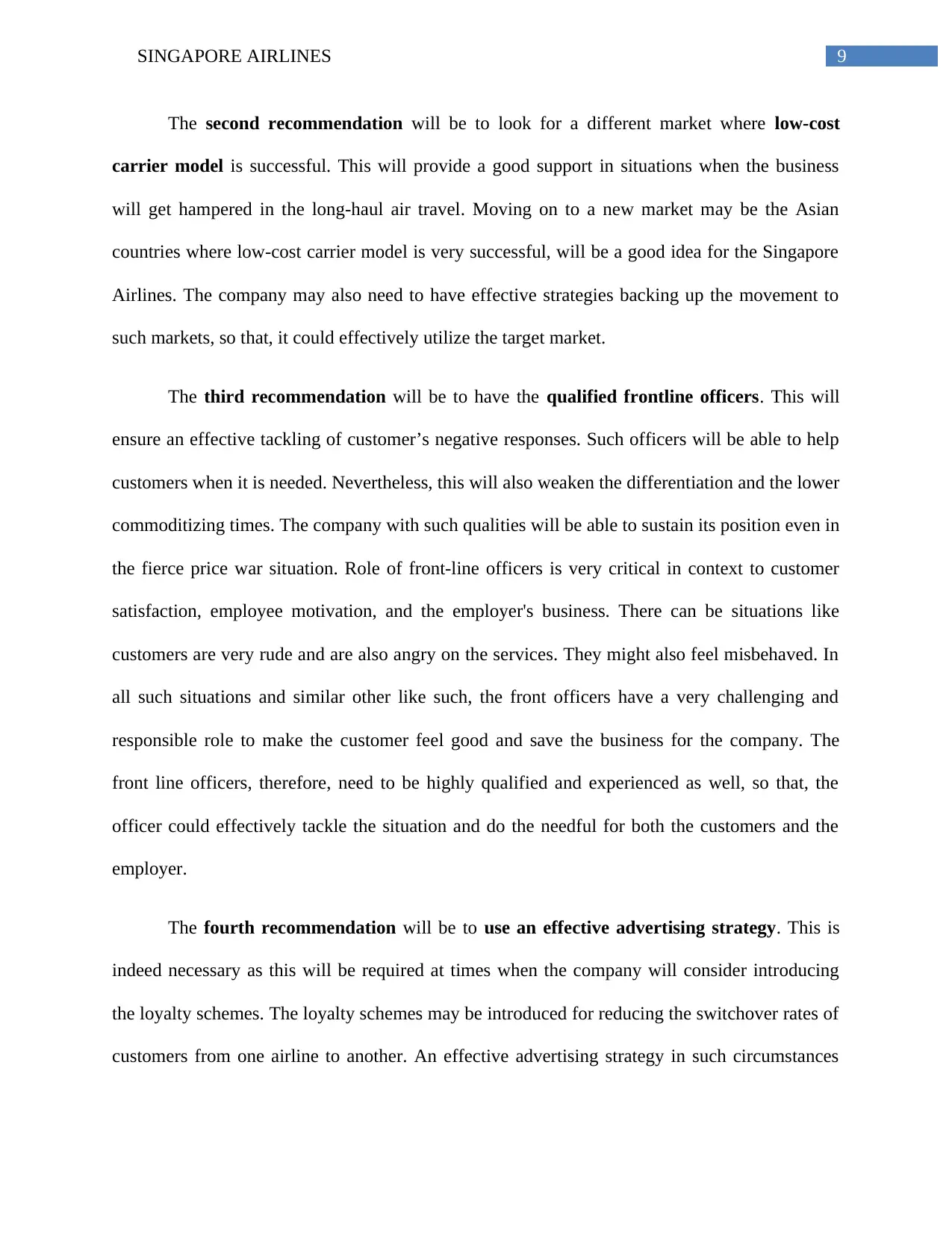
9SINGAPORE AIRLINES
The second recommendation will be to look for a different market where low-cost
carrier model is successful. This will provide a good support in situations when the business
will get hampered in the long-haul air travel. Moving on to a new market may be the Asian
countries where low-cost carrier model is very successful, will be a good idea for the Singapore
Airlines. The company may also need to have effective strategies backing up the movement to
such markets, so that, it could effectively utilize the target market.
The third recommendation will be to have the qualified frontline officers. This will
ensure an effective tackling of customer’s negative responses. Such officers will be able to help
customers when it is needed. Nevertheless, this will also weaken the differentiation and the lower
commoditizing times. The company with such qualities will be able to sustain its position even in
the fierce price war situation. Role of front-line officers is very critical in context to customer
satisfaction, employee motivation, and the employer's business. There can be situations like
customers are very rude and are also angry on the services. They might also feel misbehaved. In
all such situations and similar other like such, the front officers have a very challenging and
responsible role to make the customer feel good and save the business for the company. The
front line officers, therefore, need to be highly qualified and experienced as well, so that, the
officer could effectively tackle the situation and do the needful for both the customers and the
employer.
The fourth recommendation will be to use an effective advertising strategy. This is
indeed necessary as this will be required at times when the company will consider introducing
the loyalty schemes. The loyalty schemes may be introduced for reducing the switchover rates of
customers from one airline to another. An effective advertising strategy in such circumstances
The second recommendation will be to look for a different market where low-cost
carrier model is successful. This will provide a good support in situations when the business
will get hampered in the long-haul air travel. Moving on to a new market may be the Asian
countries where low-cost carrier model is very successful, will be a good idea for the Singapore
Airlines. The company may also need to have effective strategies backing up the movement to
such markets, so that, it could effectively utilize the target market.
The third recommendation will be to have the qualified frontline officers. This will
ensure an effective tackling of customer’s negative responses. Such officers will be able to help
customers when it is needed. Nevertheless, this will also weaken the differentiation and the lower
commoditizing times. The company with such qualities will be able to sustain its position even in
the fierce price war situation. Role of front-line officers is very critical in context to customer
satisfaction, employee motivation, and the employer's business. There can be situations like
customers are very rude and are also angry on the services. They might also feel misbehaved. In
all such situations and similar other like such, the front officers have a very challenging and
responsible role to make the customer feel good and save the business for the company. The
front line officers, therefore, need to be highly qualified and experienced as well, so that, the
officer could effectively tackle the situation and do the needful for both the customers and the
employer.
The fourth recommendation will be to use an effective advertising strategy. This is
indeed necessary as this will be required at times when the company will consider introducing
the loyalty schemes. The loyalty schemes may be introduced for reducing the switchover rates of
customers from one airline to another. An effective advertising strategy in such circumstances
Paraphrase This Document
Need a fresh take? Get an instant paraphrase of this document with our AI Paraphraser
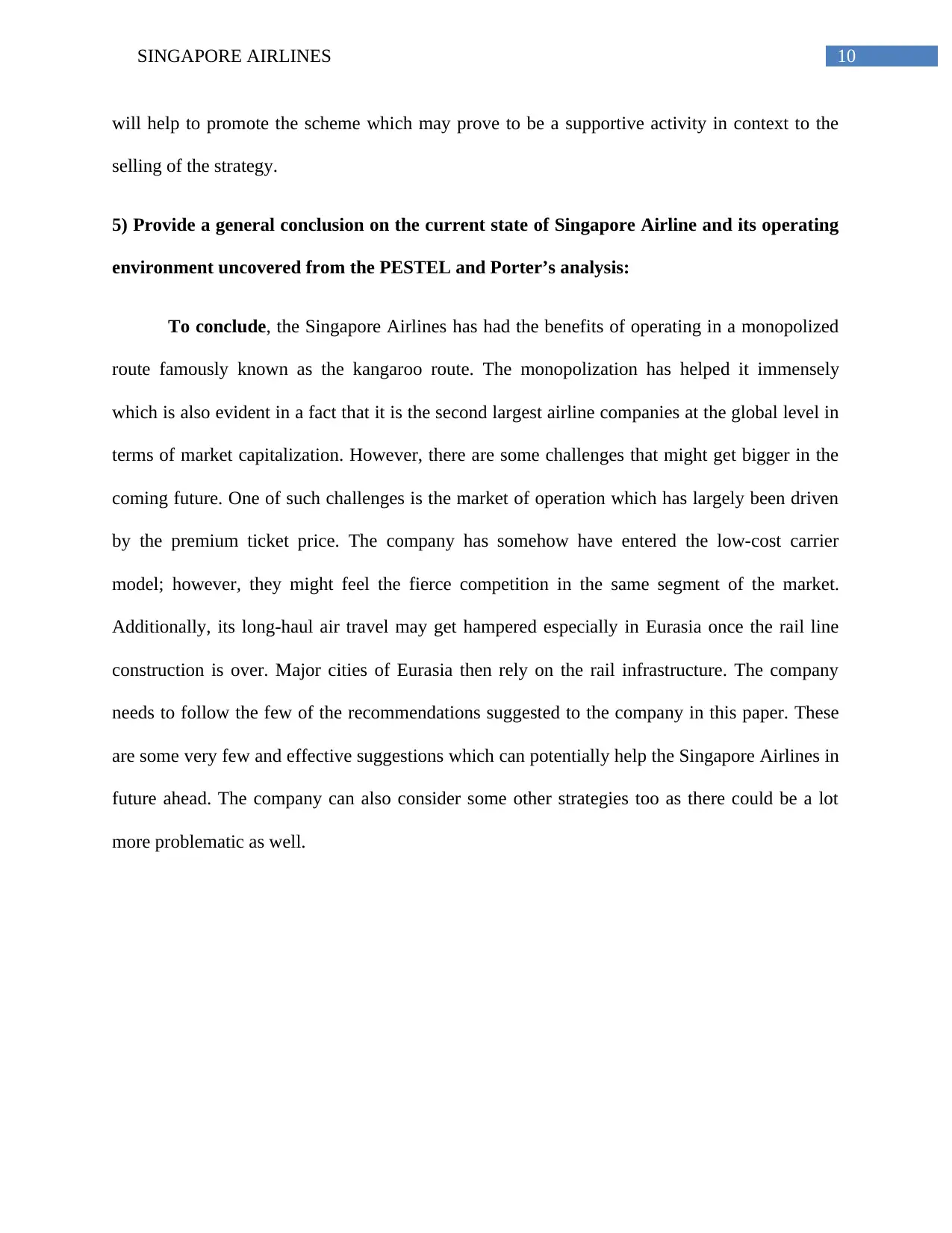
10SINGAPORE AIRLINES
will help to promote the scheme which may prove to be a supportive activity in context to the
selling of the strategy.
5) Provide a general conclusion on the current state of Singapore Airline and its operating
environment uncovered from the PESTEL and Porter’s analysis:
To conclude, the Singapore Airlines has had the benefits of operating in a monopolized
route famously known as the kangaroo route. The monopolization has helped it immensely
which is also evident in a fact that it is the second largest airline companies at the global level in
terms of market capitalization. However, there are some challenges that might get bigger in the
coming future. One of such challenges is the market of operation which has largely been driven
by the premium ticket price. The company has somehow have entered the low-cost carrier
model; however, they might feel the fierce competition in the same segment of the market.
Additionally, its long-haul air travel may get hampered especially in Eurasia once the rail line
construction is over. Major cities of Eurasia then rely on the rail infrastructure. The company
needs to follow the few of the recommendations suggested to the company in this paper. These
are some very few and effective suggestions which can potentially help the Singapore Airlines in
future ahead. The company can also consider some other strategies too as there could be a lot
more problematic as well.
will help to promote the scheme which may prove to be a supportive activity in context to the
selling of the strategy.
5) Provide a general conclusion on the current state of Singapore Airline and its operating
environment uncovered from the PESTEL and Porter’s analysis:
To conclude, the Singapore Airlines has had the benefits of operating in a monopolized
route famously known as the kangaroo route. The monopolization has helped it immensely
which is also evident in a fact that it is the second largest airline companies at the global level in
terms of market capitalization. However, there are some challenges that might get bigger in the
coming future. One of such challenges is the market of operation which has largely been driven
by the premium ticket price. The company has somehow have entered the low-cost carrier
model; however, they might feel the fierce competition in the same segment of the market.
Additionally, its long-haul air travel may get hampered especially in Eurasia once the rail line
construction is over. Major cities of Eurasia then rely on the rail infrastructure. The company
needs to follow the few of the recommendations suggested to the company in this paper. These
are some very few and effective suggestions which can potentially help the Singapore Airlines in
future ahead. The company can also consider some other strategies too as there could be a lot
more problematic as well.
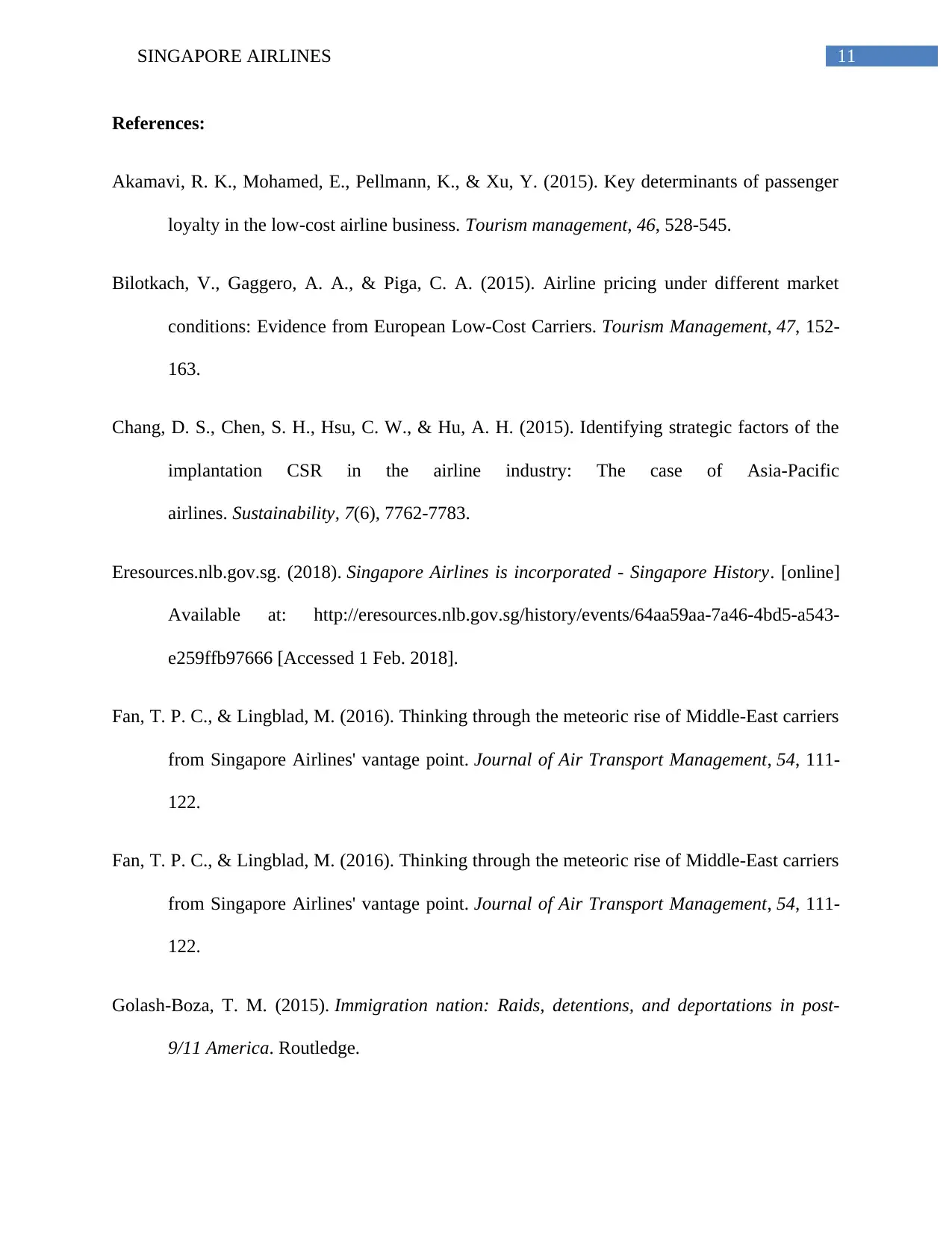
11SINGAPORE AIRLINES
References:
Akamavi, R. K., Mohamed, E., Pellmann, K., & Xu, Y. (2015). Key determinants of passenger
loyalty in the low-cost airline business. Tourism management, 46, 528-545.
Bilotkach, V., Gaggero, A. A., & Piga, C. A. (2015). Airline pricing under different market
conditions: Evidence from European Low-Cost Carriers. Tourism Management, 47, 152-
163.
Chang, D. S., Chen, S. H., Hsu, C. W., & Hu, A. H. (2015). Identifying strategic factors of the
implantation CSR in the airline industry: The case of Asia-Pacific
airlines. Sustainability, 7(6), 7762-7783.
Eresources.nlb.gov.sg. (2018). Singapore Airlines is incorporated - Singapore History. [online]
Available at: http://eresources.nlb.gov.sg/history/events/64aa59aa-7a46-4bd5-a543-
e259ffb97666 [Accessed 1 Feb. 2018].
Fan, T. P. C., & Lingblad, M. (2016). Thinking through the meteoric rise of Middle-East carriers
from Singapore Airlines' vantage point. Journal of Air Transport Management, 54, 111-
122.
Fan, T. P. C., & Lingblad, M. (2016). Thinking through the meteoric rise of Middle-East carriers
from Singapore Airlines' vantage point. Journal of Air Transport Management, 54, 111-
122.
Golash-Boza, T. M. (2015). Immigration nation: Raids, detentions, and deportations in post-
9/11 America. Routledge.
References:
Akamavi, R. K., Mohamed, E., Pellmann, K., & Xu, Y. (2015). Key determinants of passenger
loyalty in the low-cost airline business. Tourism management, 46, 528-545.
Bilotkach, V., Gaggero, A. A., & Piga, C. A. (2015). Airline pricing under different market
conditions: Evidence from European Low-Cost Carriers. Tourism Management, 47, 152-
163.
Chang, D. S., Chen, S. H., Hsu, C. W., & Hu, A. H. (2015). Identifying strategic factors of the
implantation CSR in the airline industry: The case of Asia-Pacific
airlines. Sustainability, 7(6), 7762-7783.
Eresources.nlb.gov.sg. (2018). Singapore Airlines is incorporated - Singapore History. [online]
Available at: http://eresources.nlb.gov.sg/history/events/64aa59aa-7a46-4bd5-a543-
e259ffb97666 [Accessed 1 Feb. 2018].
Fan, T. P. C., & Lingblad, M. (2016). Thinking through the meteoric rise of Middle-East carriers
from Singapore Airlines' vantage point. Journal of Air Transport Management, 54, 111-
122.
Fan, T. P. C., & Lingblad, M. (2016). Thinking through the meteoric rise of Middle-East carriers
from Singapore Airlines' vantage point. Journal of Air Transport Management, 54, 111-
122.
Golash-Boza, T. M. (2015). Immigration nation: Raids, detentions, and deportations in post-
9/11 America. Routledge.
⊘ This is a preview!⊘
Do you want full access?
Subscribe today to unlock all pages.

Trusted by 1+ million students worldwide
1 out of 14
Related Documents
Your All-in-One AI-Powered Toolkit for Academic Success.
+13062052269
info@desklib.com
Available 24*7 on WhatsApp / Email
![[object Object]](/_next/static/media/star-bottom.7253800d.svg)
Unlock your academic potential
Copyright © 2020–2025 A2Z Services. All Rights Reserved. Developed and managed by ZUCOL.





